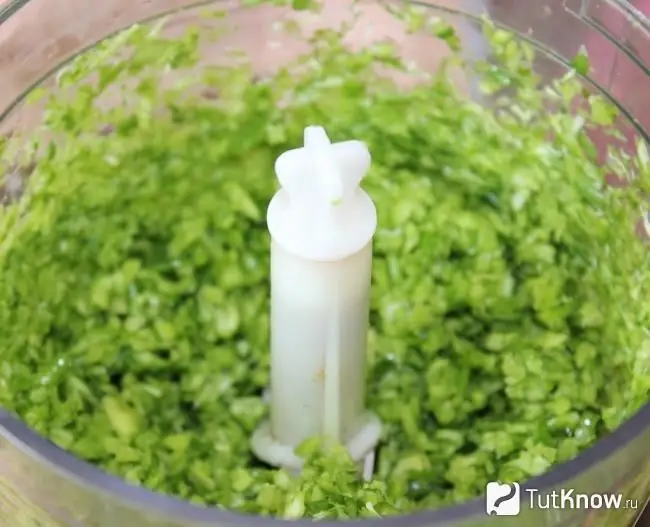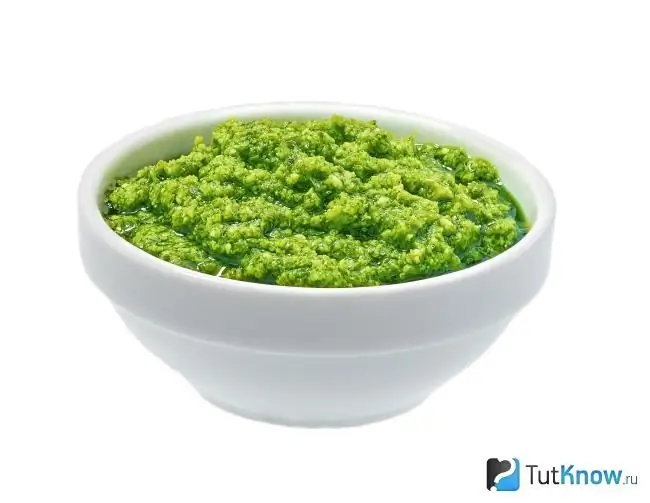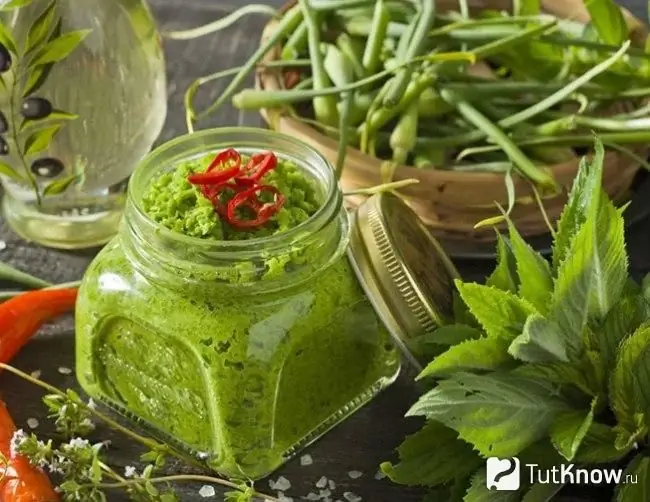What is garlic paste, manufacturing methods. Calorie content, composition, benefits and harms to the body. Cooking use.
Garlic paste is a snack, the main ingredients of which are the arrows of a perennial plant of the genus Onion and salt. Color - light green, like avocado sauce; structure - homogeneous; consistency - thick, possibly interspersed with individual ingredients. Taste - spicy, salty, with a pleasant buttery aftertaste. The smell is characteristic, but weaker than that of garlic. It is used fresh and as a preparation for the winter.
How is garlic paste made?

It is customary to use arrows as a raw material for garlic paste, but if they are not enough, fresh green leaves and aerial bulbs are taken. The arrows are cut near the bulb, rinsed in running water and the tips are removed. To remove the bitterness from overripe shoots and leaves, they are dipped in boiling water for 30-40 seconds.
How to make garlic paste yourself:
- Garlic pesto … 200 g of young arrows and 100 g of leaves are covered with 1-2 tbsp. l. salt, black pepper powder (on the tip of a knife) and let stand for 10-15 minutes. Chop with a knife into arbitrary parts, transfer to a blender, grind to a pasty state. To add sourness, pour in lemon juice - 0.5 tsp, mix thoroughly again. Garlic pesto does not need to be placed in sterilized jars. It can be stored in a quick freezer in cling film. In order for the vitamin and mineral composition to be completely preserved, it should be defrosted not under running hot water, but at room temperature.
- With tomatoes … 0.5 kg of arrows and 100 g of dill are passed through a meat grinder. Fry for 2-3 minutes, stirring constantly, in vegetable oil, add 2 tbsp. l. tomato pulp, bring to a boil, add salt and leave under the lid for 10-15 minutes.
- With tomato paste … To prepare garlic paste for the winter, it is advisable to add vinegar and red pepper to the main ingredients. The shooters (1 kg) are prepared as described. Cut into arbitrary pieces, along with a bunch of dill and parsley. The tip of the red pepper is cut off, the seeds and partitions are removed. Grind with a food processor to a pasty state with 1 tbsp. l. salt. Boil the marinade: a little water, 3 tsp. sugar, 20 peas of black pepper, 500 g of tomato paste. When the marinade boils, the shoots puree is dipped and boiled until thickened. Just before turning off, pour in 50 ml of vegetable oil, half a glass of 6% vinegar and let it boil. They are laid out in sterilized jars and tightly corked with lids.
- With cooking oil … The bowl of the food processor is filled with garlic shoots (300 g), pork fat without skin, a bunch of dill (100 g), 1 tsp. table salt, 1 g of ground black pepper. Grind to a pasty consistency. This recipe for making garlic paste can be used for preservation for the winter, only the amount of salt is increased to 1.5 tsp. and pour in 1 tbsp. l. white vinegar 9%.
- With butter … Grind 1 kg of young shoots with 100 g of butter and 3 tsp. salt. Butter can be replaced with sunflower oil (2 tablespoons).
- With ginger … Pass 150 g of garlic arrows, 100 g of ginger root, a little salt and a pinch of paprika through a meat grinder. Can be eaten fresh or placed in sterilized jars and refrigerated.
- Harissa … A handful of cumin and coriander seeds are calcined in a dry frying pan. Grind the chili pod (if you want it sharper, the seeds and partitions are not removed). Season the blender bowl with 150-200 g of garlic shoots, fried seasoning grains, a bunch of cilantro (medium size), juice of half a lemon. Salt to taste. The thick paste is laid out on sterilized jars, the surface is poured with olive oil and covered with lids.
If long-term storage of garlic paste is not required, salted shoots puree can be seasoned with mayonnaise or sour cream. Mustard or red pepper are used as flavoring additives.
Composition and calorie content of garlic paste

In the photo, garlic paste
The beneficial properties of garlic paste are preserved for 1, 5 years from the date of preparation, you can use it without additional processing. Application - universal, as a snack, vitamin and remedy.
The calorie content of garlic paste from arrows, salt and lemon juice is 25.9 kcal per 100 g, of which
- Proteins - 1.41 g;
- Fat - 0.11 g;
- Carbohydrates - 3.76 kcal
Calorie content of garlic paste with cooking fat, herbs and spices - 306.8 kcal per 100 g, of which
- Proteins - 4.1 g;
- Fat - 30.7 g;
- Carbohydrates - 3.7 g;
- Dietary fiber - 0.9 g;
- Ash - 8.819 g;
- Water - 56 g.
Vitamins per 100 g
- Vitamin A, RE - 1313.1 μg;
- Retinol - 0.003 mg;
- Alpha Carotene - 0.02 mcg;
- Beta Carotene - 1.928 mg;
- Beta Cryptoxanthin - 0.041 mcg;
- Lycopene - 0.033 mcg;
- Vitamin B1, thiamine - 0.045 mg;
- Vitamin B2, riboflavin - 0.056 mg;
- Vitamin B4, choline - 9.06 mg;
- Vitamin B5, pantothenic acid - 0.38 mg;
- Vitamin B6, pyridoxine - 0.702 mg;
- Vitamin B9, folate - 27.705 mcg;
- Vitamin C, ascorbic acid - 21.42 mg;
- Vitamin E, alpha tocopherol, TE - 0.891 mg;
- Gamma Tocopherol - 0.011 mg;
- Vitamin H, biotin - 0.066 mcg;
- Vitamin K, phylloquinone - 117.4 mcg;
- Vitamin PP - 0.9244 mg;
- Niacin - 0.171 mg;
- Betaine - 0.015 mg.
Macronutrients per 100 g
- Potassium, K - 190.58 mg;
- Calcium, Ca - 71.42 mg;
- Silicon, Si - 6.689 mg;
- Magnesium, Mg - 26.86 mg;
- Sodium, Na - 436.21 mg;
- Sulfur, S - 81.61 mg;
- Phosphorus, P - 70 mg;
- Chlorine, Cl - 669.49 mg.
Microelements per 100 g
- Aluminum, Al - 73.6 μg;
- Boron, B - 139.3 μg;
- Vanadium, V - 16.38 mcg;
- Iron, Fe - 1.083 mg;
- Iodine, I - 10.74 mcg;
- Cobalt, Co - 5.7 μg;
- Lithium, Li - 4.382 μg;
- Manganese, Mn - 1.1114 mg;
- Copper, Cu - 311.95 μg;
- Molybdenum, Mo - 38.155 μg;
- Nickel, Ni - 8.105 μg;
- Rubidium, Rb - 49.2 μg;
- Selenium, Se - 9.894 μg;
- Strontium, Sr - 43.33 μg;
- Fluorine, F - 18.23 μg;
- Chromium, Cr - 29 μg;
- Zinc, Zn - 1.1586 mg.
The garlic paste contains cholesterol (29.7 mg per 100 g), phytosterols, allicin, essential oils, organic acids (0.1 g per 100 g), 5 types of essential amino acids, 7 nonessential.
The vitamin-mineral composition of heat-treated garlic paste remains almost unchanged, but phytosterols and allicin - substances with bactericidal properties - disintegrate. But the snack with tomato paste is enriched with lycopene, an anti-cancer compound.
Useful properties of garlic paste

The snack has the properties of an immunomodulator. 1 teaspoon with breakfast during the epidemic season reduces the likelihood of getting sick by 1, 6 times.
The benefits of garlic paste
- Restores vitamin and mineral reserves.
- It has antimicrobial and anthelmintic properties.
- Stimulates the production of enzymes responsible for the digestion of food and the absorption of nutrients.
- Improves blood circulation, increases the level of hemoglobin in the blood, stops the formation of cholesterol plaques. Prevents the development of anemia and atherosclerosis.
- Increases the overall tone of the body.
- Reduces blood sugar levels.
- Reduces the likelihood of blood clots formation, thinns the blood, reduces the possibility of getting varicose veins.
- It normalizes the liver, stimulates the secretion of bile salts, and suppresses the formation of calculi in the gallbladder and ducts.
- It has a weak analgesic and pronounced anti-inflammatory effect.
Garlic paste with tomato does not have an antiviral effect and does not inhibit the vital activity of pathogenic bacteria, but other useful properties remain after a short heat treatment (no more than 15 minutes). A snack with such a composition stops the production of atypical cells, suppresses the malignancy of neoplasms, isolates free radicals circulating in the bloodstream and intestinal lumen.






